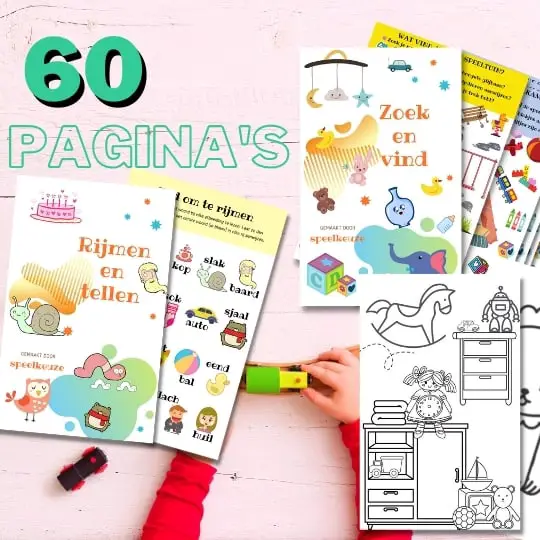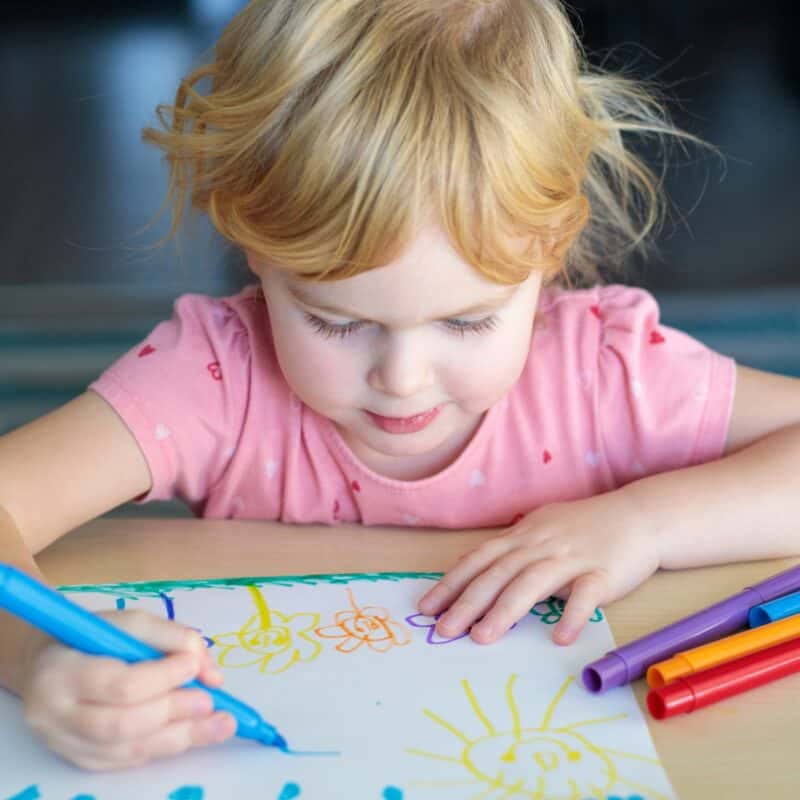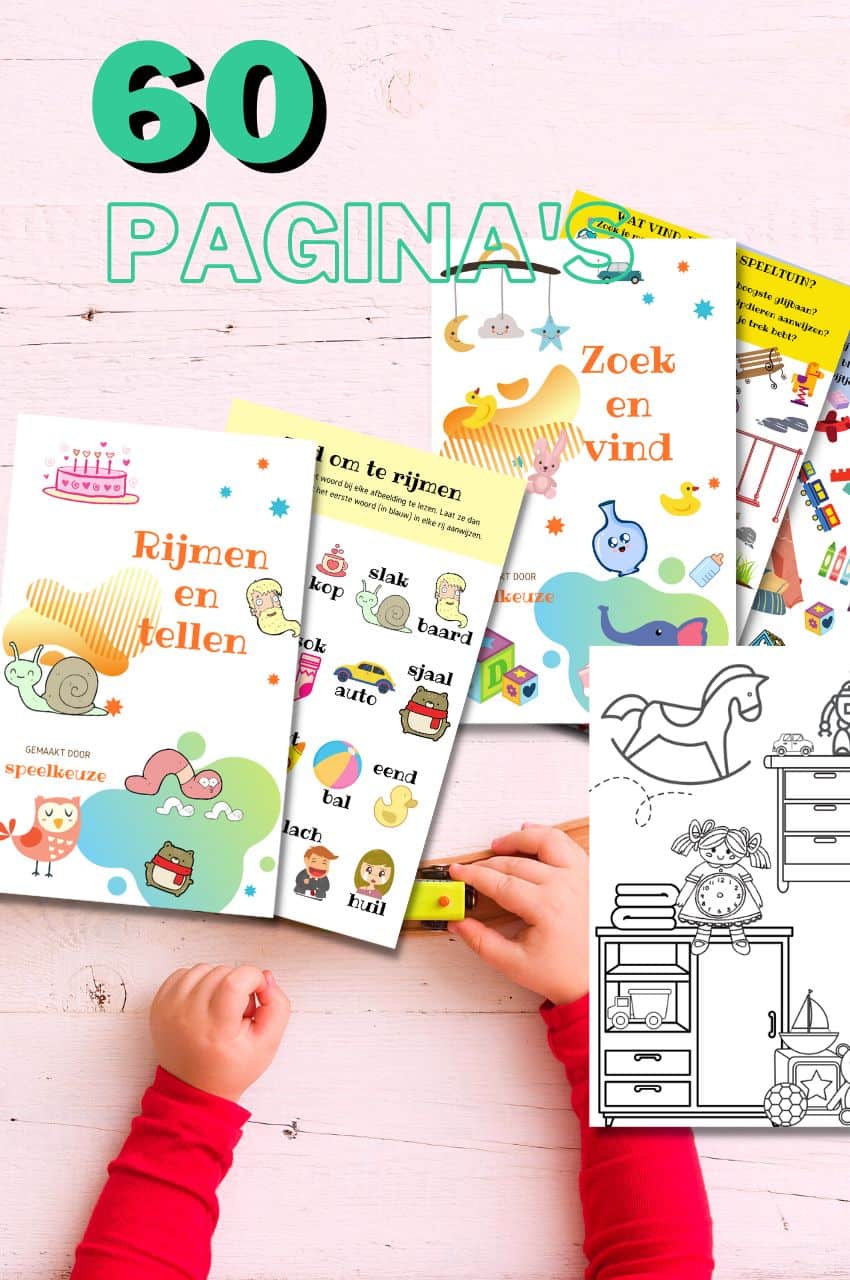Drawing for kids: 5 ways it helps their development

Always something to do for the holidays or rainy day?
Play Choice now has the ultimate activity book collection, with over 60 pages of fun coloring pages and educational puzzles.
Drawing is one of the most popular activities for children. It's a fun way to stimulate their creativity and develop their motor skills. But how does it do its job?
In this article I will tell you all about how it works and what children learn with it.


From toddler to toddler activity book collection
Educational games and coloring pages for 3 to 6 years
Your toddler and preschooler will love this e-book, along with the accompanying printables. He or she can play with it at every stage of development, together with mom and dad.
Buy at Bol.comWhat we discuss in this comprehensive post:
Should I 'teach' my child to draw?
Children discover the world around them by drawing. It is a way to express their own creativity and to develop their motor skills. It is important to remember that drawing for children is primarily a way of exploring and learning, not a perfect drawing.
Give your child space
It is important to give your child the space to draw what he or she wants. Let your child choose which colors and materials he or she wants to use. This helps your child to express themselves and to discover their own creativity.
Which materials are suitable?
In the beginning it is good to let your child draw with pencil and paper. Later you can also introduce other materials such as markers, paint and colored pencils. It's important to remember that it's not about the materials you use, it's about the opportunity to draw and explore.
Should I teach my child to draw?
It is not necessary to teach your child how to draw. Children naturally discover how to use their hands and eyes to draw. It is good to help your child if he or she asks. For example, give tips on how to make certain shapes or which colors go well together.
When can my child start drawing?
Children can start drawing as early as toddlerhood. In the beginning it will still be scribbles, but as your child gets older, the drawings will become more specific and detailed.
Nice types of drawings
There are many different types of drawings that children can make, such as:
- Nature (e.g. a tree or flower)
- Abstract shapes
- Letters and dashes
Draw more consciously
As your child gets older, he or she will draw more consciously. For example, your child will pay more attention to details and work more focused. It is good to encourage your child to draw in this way, but it is not necessary to direct your child in this.
Books and materials
There are many books and materials available to help your child draw. It's good to make these materials available, but it's not necessary to send your child in them. Let your child discover for himself which materials he or she likes to work with the most.
Later
It is important to keep your child's drawings. Afterwards you can look at the drawings with your child and talk about what he or she has drawn. This helps your child to reflect on his or her work and discover what he or she likes to draw.
What does your child draw by age?
Children start drawing at an early age, sometimes even when they are four months old. Although it may seem like just scribbling at first, it is an important way for children to develop their spatial awareness and practice their fine motor skills. So it is good to give your child a pencil and paper early on so that he or she can work on this.
Toddlers and preschoolers
If your child is a toddler, they will mainly draw circles and lines. As it gets older, it will add more details to the drawings and even draw puppets and human figures. Girls often draw dolls with long hair and boys often draw things they like, such as cars or animals.
The ideal activity
Drawing is an ideal activity for toddlers and preschoolers because it helps them fantasy and stimulates creativity. It is a problem-solving activity, as children have to figure out what they want to draw and how best to do it. It also provides insight into the child's cultural background, as it can show what it considers important and what it likes to do.
Benefits of drawing
There are many benefits of drawing for kids. It helps develop fine motor skills, spatial awareness and creativity. It can also help with learning to read and write as children learn to recognize and understand symbols and letters. Plus, it's just fun to do!
What does your child draw by age?
Below you will find an overview of what your child can draw per age:
- 1 year: scribbles and lines
- 2 years: circles and lines
- 3 years: dolls with circles for head and body, and stripes for arms and legs
- 4 years: dolls with more details, such as eyes, fingers and clothes
- 5 years: detailed drawings of people, animals and things
The best way to stimulate your child
As a parent, the best way to stimulate your child is to give them a pencil and paper and just let them draw. Give a compliment every now and then and hang up the drawings so that your child sees that you appreciate it. It's also good to give a challenge every now and then, like drawing something it hasn't drawn before.
Looking back
Review the drawings with your child afterwards and ask what they drew and why. This way you can see how it develops and you can encourage it to draw even more. And who knows, you might discover a hidden talent!
What do children learn by drawing?
From the moment a child can hold a pencil or marker, he or she starts drawing. In the first years it is mainly round shapes and scribbles, but as the child gets older, the drawings become more detailed and complex.
Fine motor skills
Drawing is not only fun, but it also helps children with their motor development.
By drawing the child develops fine motor skills and teaches to improve hand-eye coordination.
Expressing creativity and feelings
Drawing is a way for children to express their creativity and process their feelings. It gives them the space to create their own world and tell their own story. Drawing allows children to express their emotions and feelings without the need for words. It is a way to bring out their inner world and share it with others.
Draw together
Drawing together with parents, brothers, sisters or friends is not only fun, but it can also be very educational. By drawing together, children learn from each other and can help each other. It's a beautiful way to be together and communicate without words. It can also help to stimulate the child's creativity and develop new ideas.
Suitable materials and space
To make drawing for children as fun and educational as possible, it is important to provide suitable materials and space. Think of good quality pencils, markers, paint and paper. It is also important to create a quiet and pleasant place where the child can fully concentrate on drawing. Give the child the space to experiment and discover what they like.
Nicest process
The drawing process is often the best time of the day for children. It gives them the freedom to be themselves and create their own world. It is important to give children time to draw and encourage them to express their creativity. By drawing, children develop in many areas and learn new skills that they can use in the future.
Drawing is the language of children
For children, drawing is an important tool to express their feelings and tell what is going on in their head. It is a visual language that children understand and with which they can symbolize what they feel and think. Drawing is not only a way to communicate with others, but also with oneself.
Drawing stimulates development
Drawing is not only important as a language, but also as a motor training. By drawing, children develop their fine motor skills and hand-eye coordination. In addition, they learn to recognize and use shapes and lines. This helps them learn to write and read, for example.
Drawing as a reflection of the environment
Children are fascinated by the world around them and drawing is a way of understanding and processing that world. They look at their environment and try to put it on paper. In doing so, they learn more and more about colours, shapes and perspective. This is how they develop their own style and way of looking.
Drawing as product and process
A drawing is not only the end product of the drawing process, but the process itself is also important. Children often spend a long time on a drawing and puzzle until it is solved. In doing so, they learn to deal with frustration and perseverance. They also learn to organize and express their thoughts and emotions.
Drawing as brain training
Drawing is not only good for emotional development, but also for the cognitive development. It stimulates the brain and helps develop spatial awareness and creativity. In addition, it can help solve puzzles and understand abstract concepts.
Drawing and storybooks
Many children love storybooks and drawing is one way to bring those stories to life. By drawing, children can better empathize with the characters and the environment. They also learn to invent and draw their own stories.
Tips to make drawing fun and easy for kids
Drawing activities are not only fun, but also important for the development of children's creativity. It's a great way to help children imagination to develop and spend their playtime in a fun and educational way. Here are some little tips that work well to make drawing a fun activity for kids:
- Encourage your daughter to draw after you. This is a great way to help kids develop their drawing skills and improve their creative skills.
- Use child-friendly pencils and materials that do not contain harmful substances. Make sure your kids use safe drawing materials.
- Use tape to secure the sheet or sheet of paper to the table so it doesn't move while you draw.
- Use a lightpad to make beautiful drawings. This is a flat thing that you put under the sheet of paper and illuminate the drawing underneath, so your kids can copy the drawing and it looks lifelike.
- Teach your kids hand lettering. This is a great way to help kids improve their creative skills and develop their drawing skills.
- Have your kids draw on the window. This is a great way to help kids improve their creative skills and develop their drawing skills. It's also a fun way to brighten up the neighborhood.
Give your kids drawing lessons
If your kids are interested in drawing, give them drawing lessons. This is a great way to help kids develop their drawing skills and improve their creative skills. Here are some tips you can use to help your kids draw better:
- Teach your kids how to hold their pencils properly. This is an important skill that children must learn in order to draw well.
- Teach your children how to create shadows and depth in their drawings. This is an important skill that children need to learn to make their drawings look lifelike.
- Teach your kids how to create different textures in their drawings. This is an important skill that children should learn to make their drawings look realistic.
- Teach your kids how to mix colors to create new colors. This is an important skill that children should learn to make their drawings look beautiful.
Conclusion
Drawing is a fantastic way to let children explore their creativity and motor skills. It's a perfect way to develop their spatial awareness and practice their fine motor skills. It is an ideal activity for toddlers and preschoolers fantasy and stimulate creativity.
If your child likes drawing, it is the best way to teach them fantasy and stimulate creativity. Let them their fantasy and creativity, so that they can discover their hidden talents.

Always something to do for the holidays or rainy day?
Play Choice now has the ultimate activity book collection, with over 60 pages of fun coloring pages and educational puzzles.
Joost Nusselder, the founder of Speelkeuze.nl is a content marketer, father and loves trying out new toys. As a child he came into contact with everything related to games when his mother started the Tinnen Soldaat in Ede. Now he and his team create helpful blog articles to help loyal readers with fun play ideas.
